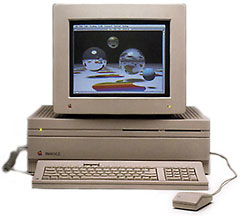Macintosh IIfx
1998.01.31. Updated 2000.08
We're sorry, but these are very old, very dated
articles. Best buys in used Macs is such a moving target that we simply
can't keep up to date and have given up even trying. Please read these
in their historical context, as some of these articles were written in
the early years of Low End Mac.
The
fastest Mac II ever, the IIfx ran a blazingly fast 40 MHz 68030
with a 32 MB static RAM level 2 cache on a 40 MHz system bus. At
that time, the DOS world was struggling with 33 MHz 80386
systems.
The IIfx was available as an upgrade to the Mac II and IIx. It
was a good value, although the upgrade meant replacing all your old
SIMMs. The IIfx used latched read/write RAM. This was a 64-pin SIMM
different from that used in any other Macintosh. This unusual
memory was one reason Apple could push the motherboard to 40
MHz.
 However, since it was
the only Mac to use 64-pin SIMMs, memory remains difficult to find
and more expensive than the common 30-pin SIMMs.
However, since it was
the only Mac to use 64-pin SIMMs, memory remains difficult to find
and more expensive than the common 30-pin SIMMs.
The IIfx was the last Mac to use the big, six-slot enclosure
introduced with the Mac II. But with six NuBus slots, it has great
potential for upgrades. You'll need a video card in one slot, but
that leaves five. Options include network cards, SCSI-2 cards (IIfx
SCSI was slower than in the IIci), and the Radius Rocket, a 68040-based
coprocessor card. (You could add multiple Rockets, each handling
its own tasks independently - or have them all working
together.)
The IIfx requires a special "black" SCSI terminator to
accommodate its unusual architecture. If you buy a used IIfx,
you'll want to have one of these so you can attach external drives.
I've also had good results using drives with active
termination.
Although pricing has dropped below US$30 (with video!) on the
used market, the IIfx remains popular among Mac cognoscenti. After
all, how many $10,000 computers can you buy for that kind of price!
It makes a great server* for a small network or a decent personal
workstation. A typical used IIfx has 8 MB RAM, an 80 or 160 MB
hard drive, and usually includes an 8-bit video card. Expect to pay
a bit more for additional RAM, 24-bit video, or an accelerated
video card.
- * Using Born Again, you can
install and run Mac OS 8.1 on a IIfx with at least 12 MB of
memory.
64-pin SIMMs are available on the used market, although they are
not cheap. And remember that you'll need to buy four at a time. 16
MB SIMMs are available; they are expensive but will let you reach
128 MB. (I have learned that 8 MB SIMMs are also available and
will work in the IIfx.)
What do you do will the SIMMs you pull? Hold on to them. There
is a solid market for the IIfx, both as logic board upgrades
(usually without RAM) and in configurations with no RAM or only one
bank filled. You can probably sell a set of four 1 MB SIMMs
for $10, 4 MB SIMMs for $40-50.
Be sure to visit the memory upgrade
guide for possible RAM configurations and installation
instructions. The IIfx supports 1 MB, 4 MB, 8 MB, and 16
MB SIMMs.
The IIfx is also one of the few Macs that can use a 5.25" hard
drive, such as the Quantum Bigfoot, so you have a lot of options
should the internal drive prove too small.
What makes the IIfx a Best Buy is its performance and
expandability.
Prices listed are approximate at the time the article was
written
<go to Best Buy
index or Mac IIfx page>

 However, since it was
the only Mac to use 64-pin SIMMs, memory remains difficult to find
and more expensive than the common 30-pin SIMMs.
However, since it was
the only Mac to use 64-pin SIMMs, memory remains difficult to find
and more expensive than the common 30-pin SIMMs.
